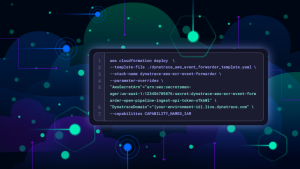With the rise of multicloud environments, many organizations are grappling with the complexity and security risks to their modern applications. As a result, organizations are looking to DevSecOps automation as a way to ensure application security in these complex environments.
Many traditional application security approaches can’t handle the increasing complexity of multiclouds that host various containers and services. Organizations are also finding that these security tools are not up to par with the increasing speed of software delivery.
DevSecOps is a methodology that brings development, security and operations teams closer together to ensure high-quality, secure application code. It helps organizations keep up with the high velocity of software releases and the complexity of multi-cloud environments. By incorporating security through every phase of the lifecycle, can help your teams operate faster and smarter with confidence.
DevSecOps automation and the importance of observability
DevSecOps is short for development, security, and operations. Building on DevOps culture and practices, it integrates security into every step of the software development lifecycle (SDLC). DevSecOps presents organizations that are already practicing DevOps with an alternate, more proactive perspective on security.
A few years ago, IT teams typically would release new software only a few times a year. They also would tack on application security checks at the end of the SDLC rather than incorporating it in each phase. But as more organizations adopt cloud-native and multicloud architecture, teams are now releasing software more frequently and running into operational complexities, including critical security risks.
Moreover, development teams are increasingly using third-party open source code to boost their productivity. This practice exposes them to vulnerabilities that can crop up anywhere in the supply chain. Finally, zero-day vulnerabilities such as Log4Shell are becoming more common. Such vulnerabilities make it vital for all teams involved in the SDLC to have visibility into their infrastructure and cloud environments to minimize the windows of opportunity for all security concerns.

The DevSecOps model encourages automation and tackling security issues at all stages of the SDLC. This way, organizations save valuable resources, time, and cost by preventing problems before they occur. DevSecOps automation encourages organizations to discover that application security should be a collaborative responsibility between all teams involved in the SDLC—including security, development, and IT operation teams—rather than a traditional, siloed approach. With DevSecOps, organizations can combine security and observability with automation, transforming the SDLC into a quicker, more secure, software release process.
DevSecOps automation promotes efficient processes and secure applications
A recent whitepaper by Deloitte,DevSecOps and the cyber imperative,” lays out some key best practices to establishing security as a shared responsibility of the entire IT organization. Here are some of the highlights of DevSecOps that Dynatrace customers have found to be fundamental:
- Automate tasks to create a seamless software development process: DevSecOps allows you to automate repetitive operational tasks. Automation allows for a more coherent process flow and establishes security controls throughout the SDLC.
- Monitor security proactively with iterative feedback: DevSecOps calls for security practices to be constantly running throughout each phase of the SDLC, including production. This protocol helps teams identify potential issues early before they snowball into bigger complications.
- Drive open collaboration between all teams involved in the SDLC: Shared security practices fill the knowledge gap that typically exists between many security and development teams on security tools and processes.
Challenges of adopting DevSecOps
Although adopting DevSecOps automation is on the rise, it does present some challenges.
- Traditional security tools are limited. Traditional security tools are not easy to use in multiple modern multicloud environments. Security tools typically rely on members of the security team to manually check and analyze problem areas. While this practice was sufficient when IT environments were more monolithic, the high-velocity and automated DevOps model requires a more automated risk management approach. DevOps must expand to DevSecOps automation so that organizations can implement cloud-native security throughout the entire SDLC.
- Security teams and tools are often siloed. Security and development teams also used to work in silos and use a variety of security tools. For instance, security teams often rely on vulnerability assessment (VA) tools to find application vulnerabilities. Development teams, on the other hand, typically use Static Application Security Testing (SAST) or software composition analysis (SCA) tools. Since both teams use different security tools, the data and results often differ, making it difficult to analyze data and develop a collective plan of action.
- Compliance requirements can cause resistance to change. Additionally, many organizations have traditional compliance-focused application security practices in place they have been using for years. Teams may resist adopting a more modern approach due to the time and effort it can take to retrain. On top of this, many members of the software development team often lack the necessary skills to understand security requirements.
To overcome these challenges, teams need to take a more holistic approach that meets the needs of cloud-native environments.
Enable DevSecOps automation with Dynatrace
To hasten an organization’s ability to adopt DevSecOps automation at scale, teams need an AI-driven platform-based approach.
Dynatrace Application Security enables your teams to overcome many of the hurdles that organizations would typically encounter with a DevSecOps model. Rather than spending valuable time and resources manually sifting through vulnerabilities and analyzing security concerns, Dynatrace allows you to automate the task of discovering and analyzing vulnerabilities.
Dynatrace OneAgent allows you to have the power of observability in your security monitoring. Dynatrace proactively collects relevant data at runtime and ensures that you are informed of any vulnerabilities or attacks as they develop. Most traditional security monitoring tools take a lengthy amount of time to run scans and vulnerability assessments. This is the critical time that affects the security of your multicloud environments. With Dynatrace, organizations can better use their time collaborating and creating a plan to remediate critical vulnerabilities faster.
Dynatrace presents intelligence and DevSecOps automation for all your applications and multi-cloud environments through contextual awareness and observability of your security. With real-time vulnerability analysis and task automation all in one place, Dynatrace Application Security empowers your teams to achieve their high-velocity software release goals.
To learn more about the need for observability in modern cloud security practices, check out the 2022 CISO Research Report.





Looking for answers?
Start a new discussion or ask for help in our Q&A forum.
Go to forum